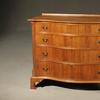Benny Andrews: Portraits, A Real Person Before the Eyes at Michael Rosenfeld Gallery
- NEW YORK, New York
- /
- September 16, 2020
Benny Andrews: Portraits, A Real Person Before the Eyes
Opening September 26, 2020
"I start out, I make a mess… I have to throw myself off so I don't copy what is right on top of my mind. Because if I just draw out or paint on something, I'm just copying what's in my mind. I'm trying to get deeper than that into my unconscious… I start out with a face and when I get a face that conveys a feeling to me of a real person, and I mean in feeling—I don't mean in realistic photographic likeness, but I mean feeling. When I get some that looks like a real face then I'm on my way… A cardboard person, no matter how real their surroundings are, [is] still cardboard. So, that's what I'm trying for... some kind of strength. Whatever it is depends on whatever I'm trying to say—happiness, love, all those kinds of things. But if I get a real person before the eyes, then I'm on my way.”[1] —Benny Andrews, 1968
Michael Rosenfeld Gallery is pleased to present its third solo exhibition for Benny Andrews (American, 1930–2006), showcasing portraits—a vital and constant genre throughout the artist’s oeuvre. Scheduled to open on Saturday, September 26, 2020, Benny Andrews: Portraits, A Real Person Before the Eyes will feature 35 portraits, represented by paintings and works on paper created between 1957 and 1998. The exhibition will be accompanied by a fully-illustrated color catalogue with new scholarship by Jessica Bell Brown, Associate Curator for Contemporary Art, The Baltimore Museum of Art; Connie H. Choi, Associate Curator, Permanent Collection, The Studio Museum in Harlem; and Kyle Williams, Director of the Andrews-Humphrey Family Foundation.
Benny Andrews: Portraits, A Real Person Before the Eyes traces Andrews’ commitment to portraiture, beginning in 1957 with Andrews’ seminal collage painting Janitors at Rest, and including portraits of fellow artists Marcel Duchamp, Ludvik Durchanek, Norman Lewis, Ray Johnson, Alice Neel, and Howardena Pindell, and also of his father George C. Andrews, and wife, Nene Humphrey. While Andrews created portraits of people he knew, as well as of himself, portraiture also served as a vehicle through which he could metaphorically express the personification of ideas, thoughts, emotions and values.
In his deeply humanizing portraits, Andrews employed his signature and pioneering use of paint and collage to build surface in order to create depictions composed of fleshy tactility, extending his sitters into three-dimensional space as a way of reinforcing their human presence and defining their distinct characteristics, since “collage provided him with a degree of depth and breadth not found in painterly realism.”[2] Indeed, his discovery of collage and texture was a way to construct surface in order to affirm his interest in both the individual and shared experience of humanity. His powerful depictions of people—both named and unnamed—reinforce his deep connection to the emotional soul of mankind.
Searching for a visual language to capture the immediacy of everyday life and the quotidian nature of his subject matter, Andrews first developed his “rough collage” technique, combining scraps of paper and cloth with oil paint on canvas, as a student. He honed this technique in a breakthrough period during his studies at the School of the Art Institute of Chicago, when, in 1957, he was struck by the school’s African American janitors and created the pivotal Janitors at Rest, which first introduced collage into his painting. This critical component would inform the rest of his artistic career. The work—begun during his last year of school—became a turning point for him as he began to completely devote himself to painting. At the same time, he began studying with the painter Boris Margo (1902-1995), “the instructor who had encouraged him to paint what he knew, what he felt.”[3] Indeed, Andrews was inspired by the janitors and their environment, studying their faces and experimenting with their materials—like towels and toilet tissues. The artist wrote:
“I placed the two little wads of tissues on a stool in front of my newly stretched canvas and sat back and started to think, Who are these men? They are the school janitors to us, Black and White, but in their minds they were much more. Yet here I am trying to think of some way to express my feelings for them that transcends the superficial jobs that they are stuck with, but how? I started fingering the two wads of paper and I thought, ‘Why not paste it on my canvas with no prescribed idea of designs or even picture, just paste it on at random. I know it is representative of an environment that they exist in, so if I put that on my canvas, and started playing around with ideas of them and so forth, maybe I’ll come up with an idea that is not so commonplace.’ I did that and then I started painting their faces. I smeared paint. I kept turning the canvas around, and I even went back to the men’s room a couple of times to talk with them that afternoon. I started working with collage that way, and I have been using it ever since.”[4]
In her essay for the exhibition’s catalogue, Jessica Bell Brown writes of Andrews’ remarkable portraits: “Taken together, these works signal what it means to be at once the beholder and image-maker, to open new portals for irreducible sensibilities unique to those being portrayed. Andrews’ empathetic brush has over the course of time straddled the line between inventiveness and observation, and honed the ability to truly grapple with all the complexities of identity and self-making. In this contemporary moment of evident and renewed socio-political reckoning, Andrews’ portraits are faithful models for holding space for the expansiveness of subjectivity and personhood in American art.”[5]
In 2008, Michael Rosenfeld Gallery LLC became the representative of the Benny Andrews Estate and this exhibition has been organized with their cooperation.
More information on Benny Andrews (1930-2006).
In light of the current public health crisis and to prioritize the well-being of our staff & visitors, the gallery is currently open by appointment only. We ask all visitors to wear a mask when inside the gallery. To schedule your visit, click here.
[1] Benny Andrews, in Henri Ghent, “Oral history interview with Benny Andrews,” June 30, 1968, transcript, Archives of American Art, Smithsonian Institution, http://www.bennyandrews.com/andrews-and-ghent.
[2] Pellom McDaniels III, “A Love of Everything: Benny Andrews, American History, and the Politics of Representation,” Benny Andrews: The Bicentennial Series (New York: Michael Rosenfeld Gallery LLC, 2017), 17.
[3] J. Richard Gruber, American Icons: From Madison to Manhattan, the Art of Benny Andrews, 1948-1997 (Augusta, GA: Morris Museum of Art, 1997), 84.
[4] Benny Andrews, quoted in ibid, 86.
[5] Jessica Bell Brown, “In Excess of Realism: Benny Andrews’ Composites,” in Benny Andrews: Portraits, A Real Person Before the Eyes (New York: Michael Rosenfeld Gallery LLC, forthcoming).
Contact:
Dan Munn, Communications AssociateMichael Rosenfeld Gallery
2122470082
press@michaelrosenfeldart.com
















